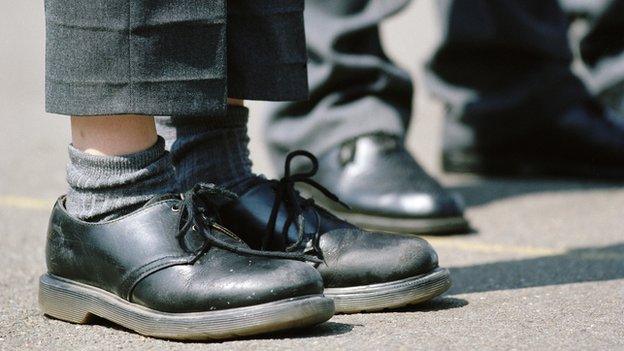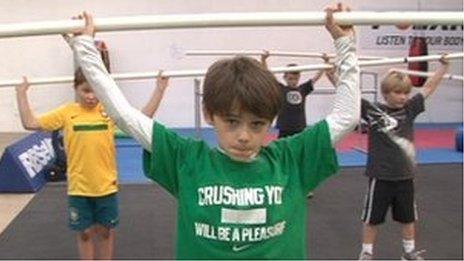Calls for schools to promote "low-level" activity
- Published

Schools should "redefine" physical activity, focussing on low-level effort rather than strenuous exercise, says a leading sports medicine consultant.
Dr Mike Loosemore argues cramming "heavy exercise" into a crowded school curriculum does not work.
He says getting children to stand up and move around more could have an extraordinary impact on their health.
Public Health England says activity must become the default choice rather than an effort.
There is growing concern over the public health impact of inactivity, particularly for the wellbeing of children.
Drop in activity
Official NHS guidelines recommend at least 60 minutes a day of activity a day for children and young people, including "moderate-intensity" pursuits such as cycling or walking to school, and "vigorous" activities such as playing chase, energetic dancing, football or gymnastics.
On three days a week these should involve muscle and bone-strengthening activities, for example sit-up and press-ups, or skipping with a rope.
The Health Survey for England (2012) indicated 21% of boys and 16% of girls aged 5-15 met these recommendations.
This was down from 28% of boys and 19% of girls in 2008.
Worryingly, nearly one in four (23%) of girls aged 5-7 met the recommended activity threshold. But for 13-15 year-olds the figure was below one in ten (8%).
"Real world"
A leading sports medic, Dr Mike Loosemore, has told BBC Radio 5live that government, local authorities and educational bodies are putting too much emphasis on "heavy exercise".
He says in the "real world", schools cannot enforce it, parents do not promote it and government cannot dispense exercise or supervise it.
"It is time to redefine physical activity in terms that are accessible, achievable and available to all. We need to think of exercise as the effect of cumulative low-level effort, not performance-orientated, data-led disciplines."
Dr Loosemore, who is lead consultant at the Institute of Sport Exercise and Health at University College London, treats elite athletes from a wide range of sports as well as NHS patients with sporting injuries.
He says encouraging low-level activity would deliver life-long health benefits.
"Simply reducing sedentary behaviour has extraordinary effects to cholesterol and blood pressure levels, even in children. Most importantly, the minor movement of muscles and increased heart rate when standing up soak up the sugars in their bodies rather than dangerous surges of insulin that can lead to diabetes."
Less roaming
Public Health England (PHE) says it is taking steps to encourage activity.
A spokesman said: "We are the first generation that has to build physical activity into our lives as it becomes less natural.
"We are seeing a generation growing up in environments that make it easier to be sedentary and children are now moving and roaming less."
"PHE agrees that we need to make physical activity the default choice, not an effort, and that there are clear distinctions between participating in sport and being physically activity."
The Managing Director of the Youth Sport Trust, Alison Oliver, emphasised the importance of teaching basic movement competence - or physical literacy - at primary school as a way of encouraging children to remain active.
"Some young people will thrive on a competitive, high octane sporting environment, but this may be a turn off for others. The challenge is to ensure that schools offer a variety of activities that get all young people active, at a level that is right for them."
A spokesperson for the Department for Education said: "As part of our plan for education, we want all children to get into healthy habits and enjoying sport in primary school. That is why PE remains compulsory at all four stages of the National Curriculum."
- Published12 November 2014

- Published20 June 2014

- Published21 November 2011

- Published26 November 2010